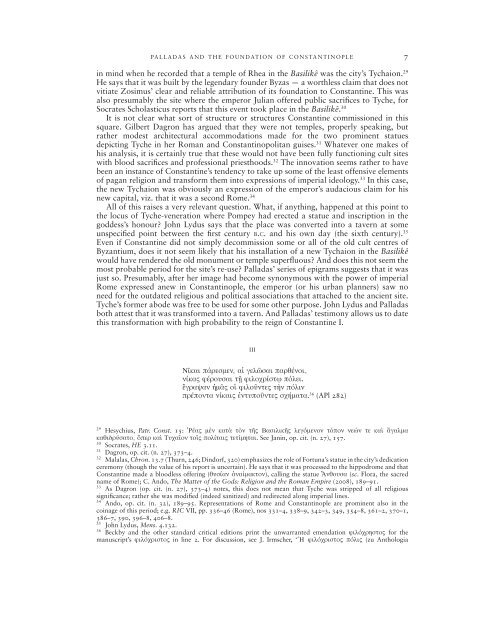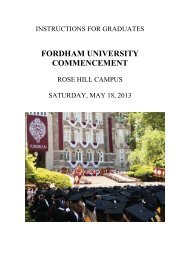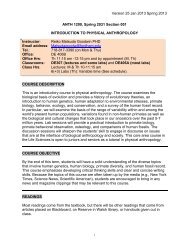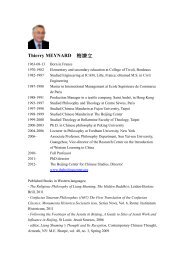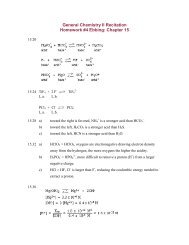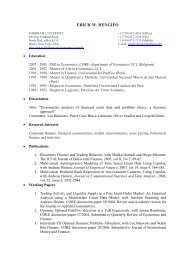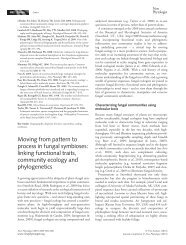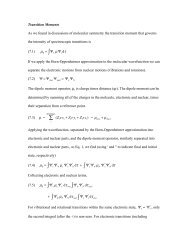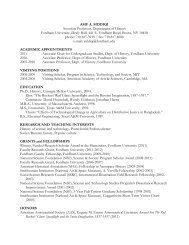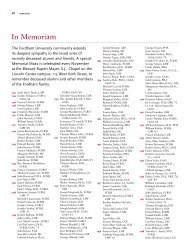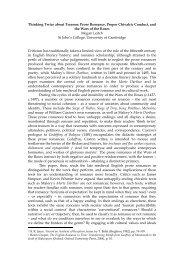Palladas and the Foundation of Constantinople - Fordham University
Palladas and the Foundation of Constantinople - Fordham University
Palladas and the Foundation of Constantinople - Fordham University
You also want an ePaper? Increase the reach of your titles
YUMPU automatically turns print PDFs into web optimized ePapers that Google loves.
PA L L A D A S AND THE FOUNDAT I O N OF CONSTA N T I N O P L E 7<br />
in mind when he recorded that a temple <strong>of</strong> Rhea in <strong>the</strong> Basilikê was <strong>the</strong> city’s Tychaion. 29<br />
He says that it was built by <strong>the</strong> legendary founder Byzas — a worthless claim that does not<br />
vitiate Zosimus’ clear <strong>and</strong> reliable attribution <strong>of</strong> its foundation to Constantine. This was<br />
also presumably <strong>the</strong> site where <strong>the</strong> emperor Julian <strong>of</strong>fered public sacrifi ces to Tyche, for<br />
Socrates Scholasticus reports that this event took place in <strong>the</strong> Basilikê. 30<br />
It is not clear what sort <strong>of</strong> structure or structures Constantine commissioned in this<br />
square. Gilbert Dagron has argued that <strong>the</strong>y were not temples, properly speaking, but<br />
ra<strong>the</strong>r modest architectural accommodations made for <strong>the</strong> two prominent statues<br />
depicting Tyche in her Roman <strong>and</strong> Constantinopolitan guises. 31 Whatever one makes <strong>of</strong><br />
his analysis, it is certainly true that <strong>the</strong>se would not have been fully functioning cult sites<br />
with blood sacrifi ces <strong>and</strong> pr<strong>of</strong>essional priesthoods. 32 The innovation seems ra<strong>the</strong>r to have<br />
been an instance <strong>of</strong> Constantine’s tendency to take up some <strong>of</strong> <strong>the</strong> least <strong>of</strong>fensive elements<br />
<strong>of</strong> pagan religion <strong>and</strong> transform <strong>the</strong>m into expressions <strong>of</strong> imperial ideology. 33 In this case,<br />
<strong>the</strong> new Tychaion was obviously an expression <strong>of</strong> <strong>the</strong> emperor’s audacious claim for his<br />
new capital, viz. that it was a second Rome. 34<br />
All <strong>of</strong> this raises a very relevant question. What, if anything, happened at this point to<br />
<strong>the</strong> locus <strong>of</strong> Tyche-veneration where Pompey had erected a statue <strong>and</strong> inscription in <strong>the</strong><br />
goddess’s honour? John Lydus says that <strong>the</strong> place was converted into a tavern at some<br />
unspecifi ed point between <strong>the</strong> fi rst century B.C. <strong>and</strong> his own day (<strong>the</strong> sixth century). 35<br />
Even if Constantine did not simply decommission some or all <strong>of</strong> <strong>the</strong> old cult centres <strong>of</strong><br />
Byzantium, does it not seem likely that his installation <strong>of</strong> a new Tychaion in <strong>the</strong> Basilikê<br />
would have rendered <strong>the</strong> old monument or temple superfl uous? And does this not seem <strong>the</strong><br />
most probable period for <strong>the</strong> site’s re-use? <strong>Palladas</strong>’ series <strong>of</strong> epigrams suggests that it was<br />
just so. Presumably, after her image had become synonymous with <strong>the</strong> power <strong>of</strong> imperial<br />
Rome expressed anew in <strong>Constantinople</strong>, <strong>the</strong> emperor (or his urban planners) saw no<br />
need for <strong>the</strong> outdated religious <strong>and</strong> political associations that attached to <strong>the</strong> ancient site.<br />
Tyche’s former abode was free to be used for some o<strong>the</strong>r purpose. John Lydus <strong>and</strong> <strong>Palladas</strong><br />
both attest that it was transformed into a tavern. And <strong>Palladas</strong>’ testimony allows us to date<br />
this transformation with high probability to <strong>the</strong> reign <strong>of</strong> Constantine I.<br />
III<br />
Νῖκαι πάρεσμεν, αἱ γελῶσαι παρθένοι,<br />
νίκας φέρουσαι τῇ φιλοχρίστῳ πόλει.<br />
ἔγραψαν ἡμᾶς οἱ φιλοῦντες τὴν πόλιν<br />
πρέποντα νίκαις ἐντυποῦντες σχήματα. 36 (APl 282)<br />
29 Hesychius, Patr. Const. 15: Ῥέας μὲν κατὰ τὸν τῆς Βασιλικῆς λεγόμενον τόπον νεών τε καὶ ἄγαλμα<br />
καθιδρύσατο, ὅπερ καὶ Τυχαῖον τοῖς πολίταις τετίμηται. See Janin, op. cit. (n. 27), 157.<br />
30 Socrates, HE 3.11.<br />
31 Dagron, op. cit. (n. 27), 373–4.<br />
32 Malalas, Chron. 13.7 (Thurn, 246; Dindorf, 320) emphasizes <strong>the</strong> role <strong>of</strong> Fortuna’s statue in <strong>the</strong> city’s dedication<br />
ceremony (though <strong>the</strong> value <strong>of</strong> his report is uncertain). He says that it was processed to <strong>the</strong> hippodrome <strong>and</strong> that<br />
Constantine made a bloodless <strong>of</strong>fering (θυσίαν ἀναίμακτον), calling <strong>the</strong> statue Ἄνθουσα (sc. Flora, <strong>the</strong> sacred<br />
name <strong>of</strong> Rome); C. Ando, The Matter <strong>of</strong> <strong>the</strong> Gods: Religion <strong>and</strong> <strong>the</strong> Roman Empire (2008), 189–91.<br />
33 As Dagron (op. cit. (n. 27), 373–4) notes, this does not mean that Tyche was stripped <strong>of</strong> all religious<br />
signifi cance; ra<strong>the</strong>r she was modifi ed (indeed sanitized) <strong>and</strong> redirected along imperial lines.<br />
34 Ando, op. cit. (n. 32), 189–95. Representations <strong>of</strong> Rome <strong>and</strong> <strong>Constantinople</strong> are prominent also in <strong>the</strong><br />
coinage <strong>of</strong> this period; e.g. RIC VII, pp. 336–46 (Rome), nos 331–4, 338–9, 342–3, 349, 354–8, 361–2, 370–1,<br />
386–7, 390, 396–8, 406–8.<br />
35 John Lydus, Mens. 4.132.<br />
36 Beckby <strong>and</strong> <strong>the</strong> o<strong>the</strong>r st<strong>and</strong>ard critical editions print <strong>the</strong> unwarranted emendation φιλόχρηστος for <strong>the</strong><br />
manuscript’s φιλόχριστος in line 2. For discussion, see J. Irmscher, ‘Ἡ φιλόχριστος πόλις (zu Anthologia


